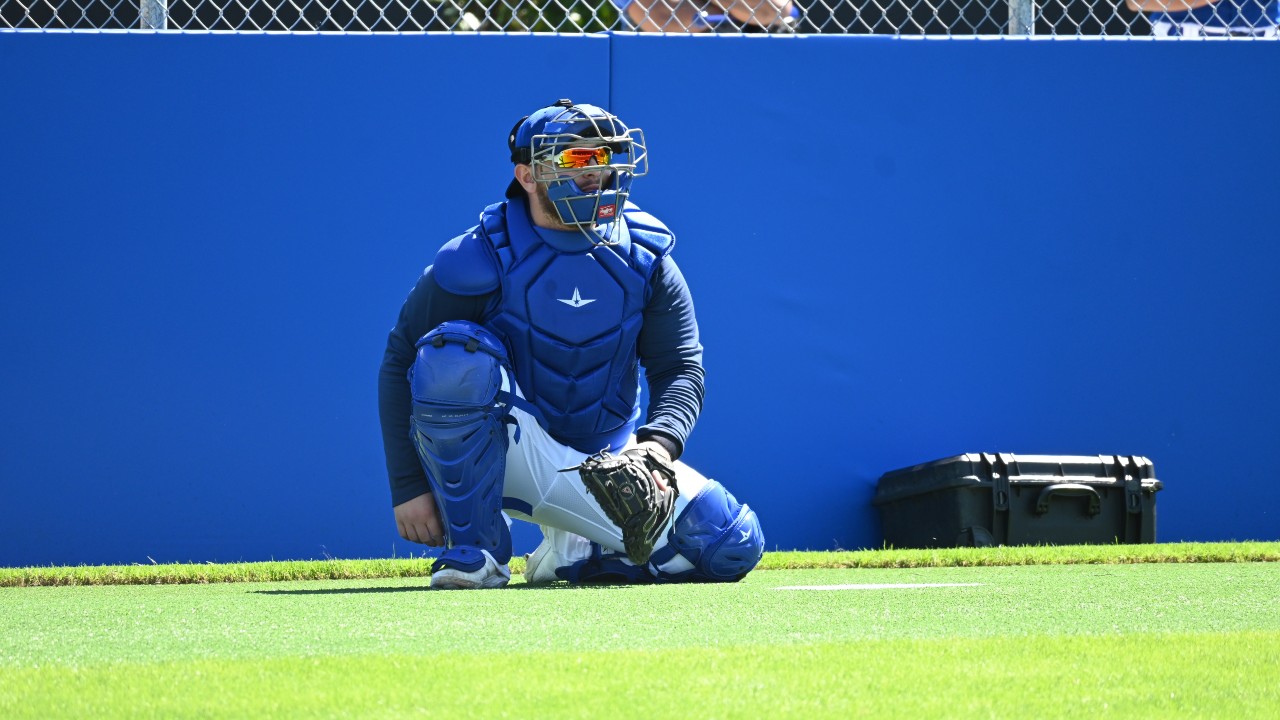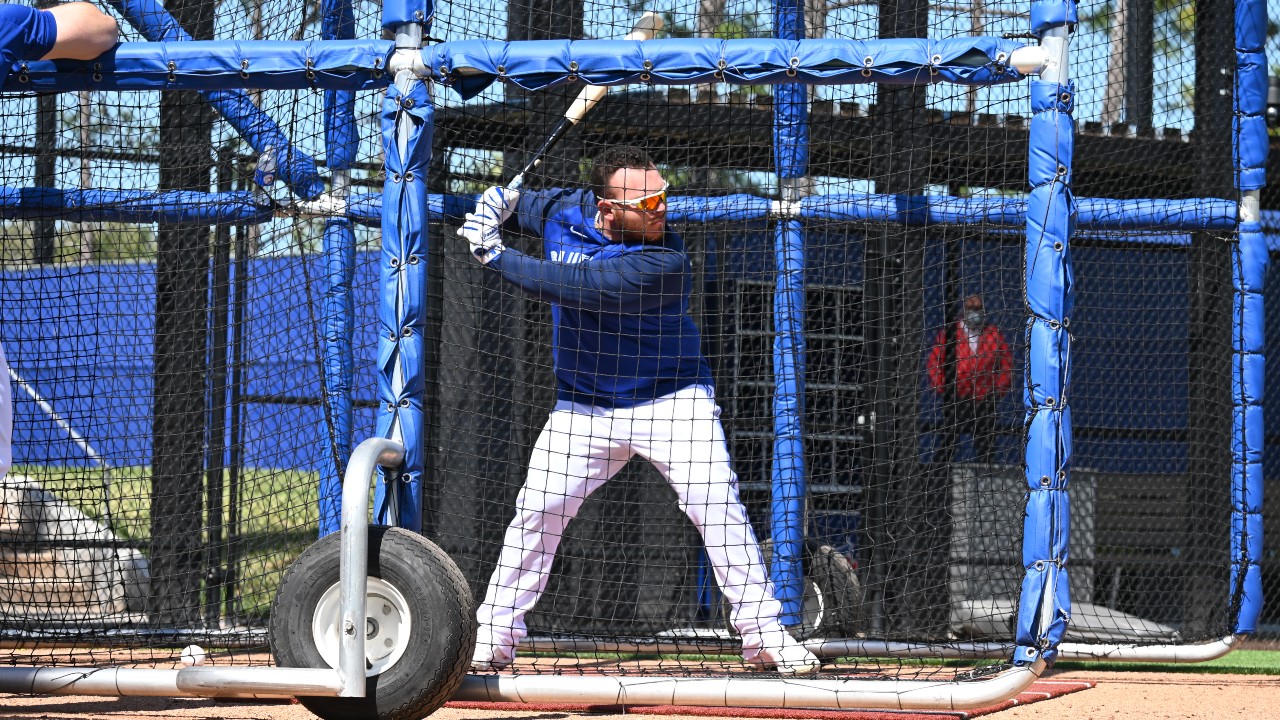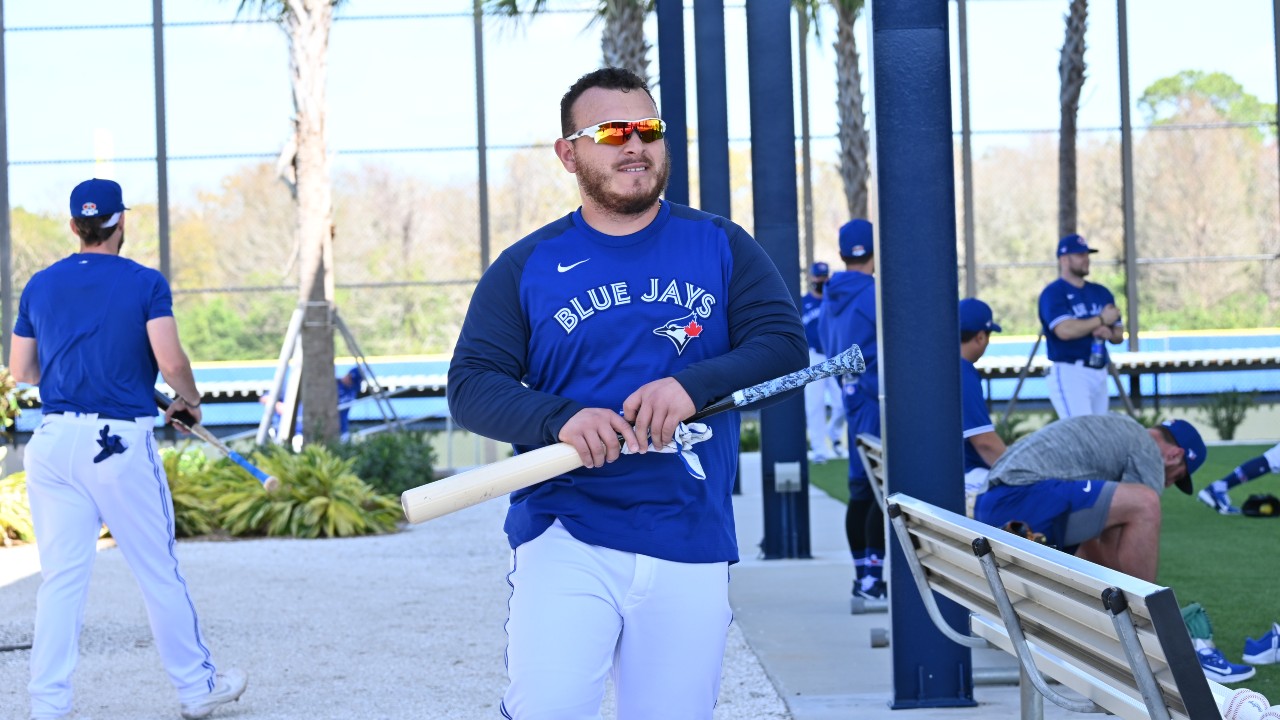So, let’s be a big-league catcher.
The day starts early because there’s entirely too much to do. Pitcher meetings to attend; game plans to learn; bullpens to catch. Strategy sessions, video study, scouting reports to digest. A mid-afternoon on-field session to hone some aspect of your game, whether it’s blocking balls a coach fires into the dirt in front of you with a pitching machine or receiving flips to practice framing pitches on the edges of the strike zone. Maybe a little extra time spent drilling your throws to the bases. Can’t let that pop time start to lag.
How’s your body feeling today? Probably not great. No position’s more physically demanding. So better make time for treatment in the trainer’s room and conditioning in the gym. Best get your protein and carbohydrates in, too — your muscles need them. But eat fast, because there’s a starter who wants to talk ahead of his outing in a couple days and a new reliever just recalled from the minors whose repertoire and tendencies you need to memorize, lest you end up catching him in a game that night. Oh, and one of the club’s PR people is trying to pull you onto a podium to spend 20 minutes giving insight to the media, because you’re expected to be one of the smartest guys in the clubhouse who has something thoughtful to say about every pitcher on the roster.
Game time’s approaching. Have you activated yet? Got to get that heart rate up; start moving around your perpetually sore knees and hips because they’re about to spend the better part of several hours under tension. Where’s your gear? Have you gone over the playcard you’ll wear on your wrist like a quarterback? Don’t miss that pre-game meeting with the pitching coach and that night’s starter. And definitely don’t make them wait for you out in the bullpen when it’s time for him to get loose a half-hour before first pitch.
[snippet id=4722869]
OK, that’s all done. Now all you have to do is call every pitch of the game — trying, in real time, to make the most optimal decisions that appropriately weigh your pitcher’s strengths, the opposition’s weaknesses, the umpire’s arbitrary strike zone, and your team’s overall strategy. That’s the mental balancing act that comes before the physical one, in which you need to receive each of those pitches while remaining cognizant of how your pre-pitch set-up could influence the batter, how your pitcher sees your target, how your torso impacts the umpire’s view of the plate, how the steadiness of your hands and wrists can make balls look like strikes or vice versa, and how all of the above lets you remain agile enough to react to cross-ups, breaking balls spiked in the dirt, and wildly missed locations, with the possibility of needing to throw accurately behind a runner at first base or, ideally, ahead of him as he tries to steal second or third.
Oh, and then you’ve got to try to hit major-league pitching three or four times, something a designated hitter spends his entire day preparing to do and still routinely fails at. It’s the last thing you’ve had time to adequately work on today, yet the aspect of your game most noticeable to the common fan, and, despite the fact your position averages an OPS of around .700 league-wide most years, most likely to be criticized if you’re not being as successful at it as many expect you to be. Which is funny, because hitting’s the one thing no one questions Alejandro Kirk’s ability to do.
It’s all that other stuff. The preparation, the routines, the downright insane grind that life as an MLB catcher entails. Forget just baseball — it’s one of the most demanding jobs in professional sport. And over the next six weeks at Toronto Blue Jays spring training, Kirk, a 22-year-old with all of nine games played above high-A who’s nonetheless competing with Reese McGuire to be Toronto’s secondary catcher behind Danny Jansen, will do everything he can to prove he’s up to the task. Because he convinced himself he was long ago.
FIRST @MLB HOMER!
Have yourself a night, @alejandro_kirk! #BlueJaysonSN pic.twitter.com/9oL8VmK2D4
— Sportsnet (@Sportsnet) September 22, 2020
“Definitely; definitely. I feel like I’m ready for the big-leagues,” Kirk says through interpreter Hector Lebron. “I prepared myself and I worked very hard in the off-season for that. And I’m here to compete for a spot in the big-leagues.”
That off-season work — completed at Kirk’s home in Tijuana, Mexico — focused mostly on nutrition and conditioning to address his body composition, an obvious area of needed improvement for a professional athlete who was listed last season at 5-foot-8, 265-pounds. And there’s no doubt he’s worked hard at it. Judging by early spring images, he’s noticeably leaner. Kirk says he isn’t certain exactly how much weight he’s lost — “I know I lost a lot” — only that he feels nimbler behind the plate and like he can turn on inside pitches more effectively.
That last bit is a hell of a thing to imagine because Kirk’s prodigious bat is what forced the underdeveloped prospect to the majors from Toronto’s alternate site with two weeks remaining in the 2020 season. The ball just explodes off of it. Half of the 20 pitches he put in play during those two weeks carried exit velocities of 97 m.p.h. or harder. Nine of them were over 103. Combining an advanced ability to manage the strike zone with a patient selectivity that’s allowed him to walk 29 more times than he’s struck out in his minor-league career, Kirk finds his way to good pitches to hit, and barrels them on sight.
“He can hit,” says Blue Jays pitching coach Pete Walker. “We know that.”
And the legend continues!
Alejandro Kirk drives in two runs to give the @BlueJays a 4-0 lead.
Catch all the action on SN + SN NOW. #BlueJaysOnSN pic.twitter.com/BPAP5TdmHO
— Sportsnet (@Sportsnet) September 25, 2020
It’s difficult to envision how Kirk’s first taste of big-league ball could have gone much better. He reached base twice in his debut; he went 4-for-4 against the Yankees days later; he singled off Gerrit Cole and laced a two-run double off Adam Ottavino. And he looked the part behind the plate, earning strong reviews from veteran big-league pitchers who’d surely never heard of him months prior.
“He did some nice things back there. Guys got comfortable throwing to him. He’s got a very good way about him behind the plate,” Walker says. “I think the guys enjoyed throwing to him.”
The Blue Jays threw Kirk right into the defensive deep end for his debut, tasking him with catching Robbie Ray, an effectively wild veteran who whips high-spin, swing-and-miss stuff, but doesn’t always know where it’s going, which is why he leads MLB with 341 walks since 2016. The result? Ray had one of his best games of the season, allowing only a run over five innings, his deepest start as a Blue Jay.
“He did great,” Ray says. “We came into the game, we went over the scouting report. He was on board with everything. Honestly, there was a couple times during the game where I wanted to throw a pitch and he threw something else down — and he was so convicted in the way he threw it down that I just threw the pitch. Because I believed in him. And that handful of times, it actually ended up working out. Because he channelled that conviction in the pitch to me.”

(Credit: Toronto Blue Jays)
It went so well the Blue Jays put Kirk back behind the plate for Ray’s next outing, too. Just 21 and catching his first innings above high-A, Kirk kept finding new ways to impress.
“I think he’s got great hands,” Ray says. “He catches the ball, receives really well. Strong wrists. He can catch that low ball really well. It definitely surprised me how good he was back there.”
It’s certainly a good foundation. But he’s nowhere near a finished product. Beyond the mere conditioning — which will remain a work in progress for years — Kirk still needs to grasp the finer points of communicating as a catcher, handling a pitching staff, preparing for games, and staying on top of the myriad responsibilities that come with the role. It’s not that he can’t. It’s that he hasn’t had the opportunity to, with only 160 professional games played in his life. The last time Kirk was an everyday catcher during a real baseball season was at high-A in 2019. Doing the same thing in the big-leagues is like going from a walk around Central Park to running the New York City marathon.
“I really believe that the routine in the big leagues is pretty much the same. But it’s faster. A little bit harder. Everything is, like, fast,” Kirk says. “But I did get used to it. And it helped me out a lot with preparing myself in the off-season to be ready for this year.”

(Credit: Toronto Blue Jays)
That preparation included plenty of video study, assessing not only his own past performance but how other big-league catchers control games behind the plate and guide pitchers through outings. Kirk reported to the Blue Jays development complex more than a month ago to continue that process and establish better relationships with Blue Jays pitchers who were there working out ahead of camp.
No one denies his effort. But is it enough? Would the Blue Jays be comfortable starting the season with Kirk in the big-leagues as an unfinished product still in need of considerable development, considering the offensive thump he’d bring with him?
“It’s certainly a realistic scenario for him to be a back-up in the major-leagues. Balancing what’s best is the question,” says Blue Jays GM Ross Atkins. “We’ll have to factor in, one, how he’s performing and how he’s recovering, and then two, what our options are internally. Of course, we have to consider externally, too. Balancing all of that, we’ll see. We’ll determine what’s not only best for him — but you always have to factor in what’s best for the organization, as well.”
That the five catchers on Toronto’s 40-man roster are all young and developing talents presents both a boon and a dilemma for the club. It’s an area of intriguing depth that could either supply the major-league roster for seasons to come or be used in trade to address other positional deficiencies. But all those raw athletes need playing time to continue their growth, and there’s only so much of it to go around. Particularly if the minor-league season is delayed and MLB begins the year operating with an alternate training site structure as it did in 2020.

(Credit: Toronto Blue Jays)
In that scenario, the only live game repetitions to be had this April would come in the majors, where Jansen will soak up the majority of playing time, while one of Kirk or McGuire — who’s out of minor-league options — serves as Toronto’s secondary catcher. The odd man out could stick around the major-league club on the taxi squad, catching bullpens and sitting in on pre-game meetings, but he wouldn’t have the opportunity to continue developing in-game.
That individual also wouldn’t benefit from participating in live at-bats and simulated games at the alternate site, or even actual games whenever the triple-A season begins. And even then, the club would have to decide who between Kirk/McGuire, Riley Adams, Gabriel Moreno and under-the-radar non-roster backstop Phillip Clarke is given the most playing time at triple- and double-A.
Only an injury or trade could alleviate that particular problem, which, to be clear, is a good one to have. But the taxi squad dilemma could be solved by the Blue Jays signing a veteran catcher on a minor-league deal to assume the role Caleb Joseph filled on the 2020 team — a proven big-leaguer to protect against injury while serving as a resource for Toronto’s young catchers to learn from. Joseph’s a free agent — and considering the strong impact he had on the club’s culture last season, a reunion would make sense. Veterans Tyler Flowers and Matt Wieters also remain unsigned and could fill the role.
Which is all to say, don’t be surprised if the Blue Jays add one more catcher to this crowded mix in the coming weeks. But that still leaves the question of how to optimally roster the five currently on the 40-man — one the Blue Jays have six weeks to answer. McGuire’s un-optionable status makes him an obvious fulcrum in the equation. If the club prioritizes depth above all else, it’ll have McGuire in the majors on opening day and send Kirk to the taxi squad, triple-A, or alternate site. If Kirk builds on his remarkable debut and wins a big-league job out of camp, McGuire could be traded or exposed to waivers, where there’s a decent chance he’d be claimed.
[snippet id=3305549]
The club obviously wouldn’t want to lose one of its young catchers for nothing. And although Kirk’s 2020 debut was electric, it’s a 25-plate-appearance sample. Buy too much stock in that at your own risk. Still, considering his natural ability at the plate and quickly progressing game behind it, there’s a decent argument to be made that Kirk is Toronto’s second-best catcher today and could continue his development at the big-league level while giving a team with postseason aspirations its best chance to win on a nightly basis. Again — a boon and a dilemma.
“It’s such a good situation to be in,” Atkins says. “Reese, we feel confident can perform defensively; and if his offence comes around, he’s a very valuable piece. And then Alejandro, as young as he is, has shown us all of the attributes that it takes to be a major-league catcher. It’ll be, for him, a matter of just durability and being able to handle those rigours with such a limited foundation. So, we’ll have to be cognizant of that with him. But it’s a great situation.”
For his part, Kirk’s focus is on continuing to improve, trying to make a team, and not worrying about the rest. What other option does he have? There already aren’t enough hours in the day for everything big-league catchers are asked to do. The last thing Kirk has time for is pondering factors outside his control.
“Definitely it’s a competition. But I don’t focus on that. Actually, I learn from them,” Kirk says of Jansen and McGuire. “They’re young, but they’re older than me. We have a great relationship between us three. I understand this is sport and this is competition. And whatever happens at the end, happens. But all three of us, we’re good. We’re all in the same position right now. So, we’ll see what happens. But we talk every day. We have a great relationship.
“The bottom line is that I feel great right now. A lot better than last year. I’m moving well. I’m happy. And I’ll keep working hard.”
[relatedlinks]





COMMENTS
When submitting content, please abide by our submission guidelines, and avoid posting profanity, personal attacks or harassment. Should you violate our submissions guidelines, we reserve the right to remove your comments and block your account. Sportsnet reserves the right to close a story’s comment section at any time.